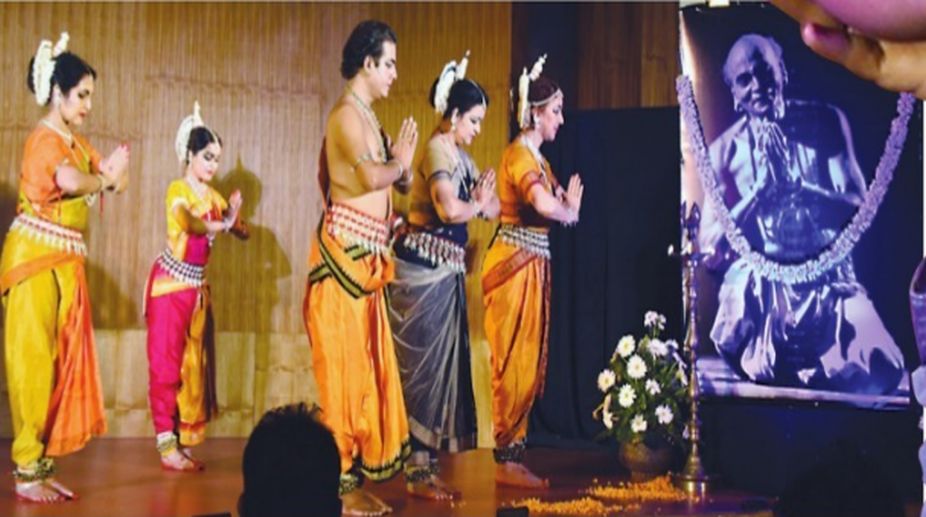At the masters feet
It was a happy collection of dancers that had gathered to showcase the timelessness of Guru Kelucharan Mohapatra’s choreographic works.…

Samsmaranam (PHOTO: SNS)
It was an auspicious event when I met legendary Guru Kelucharan Mohapatra’s former disciples as Srjan was observing the 13th year of his passing. People who knew him closely spoke about their interaction with him and one got a rare glimpse of the man and the master.
Ileana Citaristi, his disciple from 1979, was the master of ceremonies and conducted the morning seminar suitably. The first speaker, Ananga Dwivedi threw much light on Mohapatra’s life. He said in his travels, all he saw was the airport, the hotel and the stage! Communication was never a problem as he would explain things through drawings. Ratikant revealed how is father had a detailed discussion with Dr Devi Shetty, after his open heart surgery, to devise a method of dancing without causing any discomfort. Mardala stalwart Satchidananda Das said that Mohapatra’s mardala playing was nothing but poetry where every beat was different. Sneha Samant Ray described him as a karmayogi. Ramesh Chandra Das remembered him as a person possessed with an amazing sense of humour, calling him Jibanta Iswar (living god). Citaristi said that he was the instrument of her destiny.
The evening was taken up by the former disciples of the legend to showcase the choreographic works of Mohapatra. Rajib Bhattacharya performed Hamsadhwani Pallavi, Citaristi performed Dheera samira Yamuna teere, Itisree Devi performed Brojo ki chora asuchi, Sikata Das did Patho charide mu jibi phulo tulite, Pranati Mohanty performed Kuru yadu nandana and Rajashree Praharaj performed Ardhanariswar. On the next evening, Ratikant Mohapatra’s repertory members superbly performed a combination of their guru’s recent compositions.
Advertisement
I had the privilege of talking to Itisree Devi and Pranati Mohanty on this occasion and came to know a few interesting facts about their life under Guru Kelucharan Mohapatra. From the time Pranati Mohanty was doing her Masters at the Kala Vikash Kendra, she, like other budding Odissi dancers, had aspirations to learn from Mohapatra. She had the good fortune of being taught by him during two consecutive summer special classes at Kala Vikas Kendra but had no close interaction with him then. She cherished the desire to be close to Guru ji but soon after, he left Kala Vikas Kendra.
The big chance came to her in 1977. In the same year, the Science Congress was to take place in Vani Vihar in Bhubaneswar, where Indira Gandhi was to be present and Guru ji was asked to choreograph Konark Dance Drama. He was therefore in need of many dancers. He requested Kishore Mohanty, his disciple, to look for suitable candidates. Mohanty approached her and Pranati was thrilled to bits. However, such was her awe at the larger-than-life personality of Mohapatra that when she neared the entrance of his house, she got nervous!
With her were many dancers like Nandita Patnaik, Sikata Das, Tapaswini Sahoo, Itisree Devi, Nandita Samuel and others. In summer, Mohapatra held classes, which started at 9am and continued till 3pm. After which there was lunch break. Guru ji had lunch with his disciples and classes again started at 5 pm and continued till 10 pm, for those who were not residential students. That too Guruma (Guru Kelucharan Mohapatra’s wife Lakshmipriya) had to remind him to let them go. For the others, classes continued till midnight. Those who left had to come early enough to catch up with the previous day’s lessons.
A stickler for strictness and a perfectionist to the core, Mohapatra directed his disciples to learn one piece a year and go through the rigour of practice the rest of the time to acquire mastery over it. Two of his illustrious students, Debi Chatterjee and Jhelum Paranjpe used to join the summer classes too. Once they told Guru ji why Pranati, clad in a simple saree, looks more like a Odissi dancer than them. Guru ji did not have the habit of saying any negative things to anyone. But that day Pranati got her answer. He said that whatever she is doing is pure Odissi as she knows no other form to influence her.
Every Sunday, the disciples had to go to Guruma in the absence of Guru ji and practise on recorded music. But that in no way meant that Guru ji did not keep a tab on them because Guruma would invariably tell him everything. Because of the way they were taught Pranati and others, like her, are what they are today.
Unfortunately people like Pranati Mohanty and Itisree Devi almost bade dance farewell once they got married. No girl of a Brahmin family was allowed to take up dance as a profession. If at all they had to perform, they had to do it on the sly. It was rather sad. Here was Pranati Mohanty — who according to Ratikant Mohapatra — was poised to fill the place, which Sanjukta Panigrahi had left vacant but marriage came in the way.
Advertisement